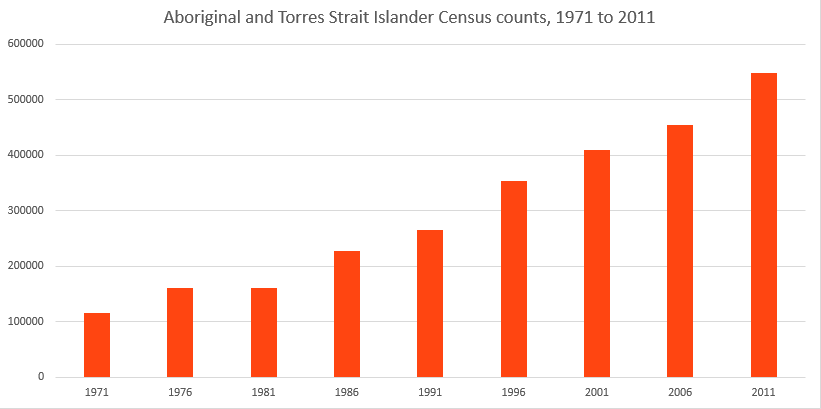The 1967 referendum, 50 years on
27 May 2017 marks the 50th anniversary of a landmark referendum for the Aboriginal people of Australia.
Harold Holt’s government called the 1967 referendum to make two significant changes to the wording of the constitution, to recognise Aboriginal people in Australia, amending the constitution to allow the government to pass laws relating to Aboriginal people (or, more accurately, including Aboriginal people in the laws passed by the government, rather than passing separate federal laws), and counting them in the population.
(Contrary to popular belief, it didn’t confer Australian citizenship on Aboriginal people, nor did it give them the right to vote – prior to this, Aboriginal people mostly had the vote, some as far back as the late 1800s, but this was administered differently in each state. Mostly, Aboriginal people were able to vote in all states from 1949).
Counting Aboriginal people in the Census
It’s also not true to say Aboriginal people weren’t counted in the Census prior to 1967. Aboriginals have been counted, in fact, right back to colonial Censuses. In Victoria, the 1851 Census recorded 2,693 Aboriginal people! (Source: ABS, 3105.0.65.001 Australian Historical Population Statistics), but they were never included in the official population estimate (what we know now as Estimated Resident Population).
Prior to 1967, the Census asked questions on race, and in many years asked rather intrusive questions (for example about percentage Aboriginal blood), which were then used to exclude Aboriginal people from the population, for purposes such as determining electorates (which is one of the primary purposes of the Census and population counts generally).
The most popular referendum in Australia’s history
The 1967 referendum remains the most overwhelmingly supported referendum in Australia’s history. Most referenda don’t get through in this country. Of the 44 items put to the Australian people since 1901, only 8 have been carried. The 1967 referendum was carried by the greatest margin of all, a 91% “Yes” vote.
After 1967, the 1971 Census was the first to officially include Aboriginal people as part of the total population, marking the beginning of the way we record the population right up to the present day.
The modern concept of Estimated Resident Population was introduced after this Census as well, when we started counting people based on where they usually live (initially just at a state and broad regional level; now we can go right down to individual neighbourhoods by usual residence).
We still have a specific question on Aboriginality in the Census. The Census now asks “Is the person of Aboriginal or Torres Strait Islander Origin?” But this is very much a question of “identification”, rather than asking about bloodlines.
Increasing identification
Every Census, the Aboriginal and Torres Strait Islander population grows. The 1971 Census recorded 115,953 Aboriginal people (0.9% of population). Interestingly 5 years prior, before the referendum, the 1966 Census recorded 101,000 – not a lot less!
By 2011, this had grown to 548,126 – a 5-fold increase, with people identifying as Aboriginal representing 2.5% of the total population. While some of this is due to a higher fertility rate among Aboriginal people, the bulk of the change it is due to a greater propensity (or willingness) to identify with Aboriginal and Torres Strait Islander ancestry over time.
The chart below shows the growing Indigenous population of Australia by Census, from 1971 to 2011. It’s also likely that the 2016 Census will show a similar increase of around 20%.

Of course, the Indigenous population is included in the total population for all the Census years included in our profile.id tool. All our profile.id subscribers can see their Aboriginal and Torres Strait Islander population by suburb/district using the “Population summary” page, under the population heading.
If you have id’s social atlas tool, there is a map under the “Diversity” heading, which looks at the distribution of Aboriginal/Torres Strait Islander population across your area.
A continuing story of disadvantage
Unfortunately, despite continuing improvements in recognition and inclusion, Indigenous people remain disadvantaged in many areas, and in many of the measures that correlate with social disadvantage.
Due to lower life expectancy, Indigenous people are generally much younger than the total population. Furthermore, Indigenous people have, on average, lower education levels, lower incomes, and are more likely to live in single-parent families and rent in public housing.
However, this is not the case in all areas. Councils have the option to add an “Indigenous Profile” to profile.id to better understand the changing characteristics of Aboriginal people in your local area, with comparisons to the state average, and to the total population. Many councils already subscribe to the Indigenous profile tool, for example, see the City of Campbelltown’s Indigenous profile here.
Missing the Indigenous Profile for your community?
If you’re a local council interested in better understanding Aboriginal people in your area using .id’s Indigenous profile, get in touch with us and we’ll get you set up. You can subscribe to an Indigenous profile as a “Community of Interest” (a paid module), which allows users to delve deeper into the Census data.
Coming soon: 2016 Census data
New Census data will be released by the ABS later next month, on June 27th and will be updated in our community profiles very soon after that. You can read more about the release schedule for 2016 Australian Census data here.
The new census data will provide valuable insights to the stories of indigenous Australia (we would expect another significant increase in the population identifying as indigenous), as we work to build a better society for all Australians.
And for more information on the 1967 referendum, and how it effected the lives of Aboriginal people at the time, watch “Counted” on ABC TV on Friday 26th May.
.id specialises in analysing and presenting Census data in user-friendly online information tools. You can access .id’s community websites to see the demographic profile characteristics for over 250 local government areas in Australia and New Zealand.










